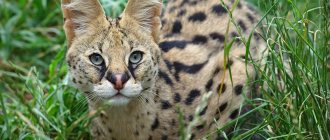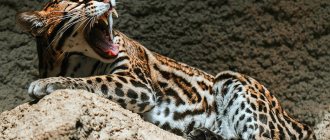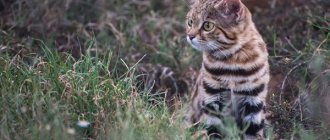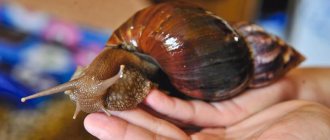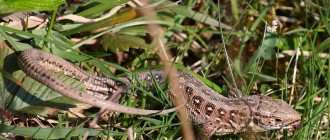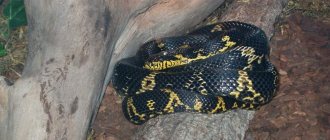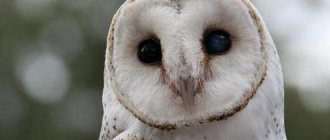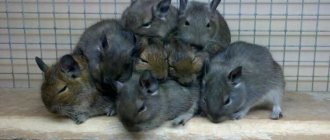- Wild animals
- >>
- Mammals
The Temminck cat , known as the "fire cat" in Thailand and Burma, and as the "stone cat" in some parts of China, is a beautiful wild cat that is medium in size. They make up the second largest category of Asian cats. Their fur varies in color from cinnamon to various shades of brown, as well as gray and black (melanistic).
Origin of the species and description
Photo: Temminka the Cat
Temminck's cat is very similar to the African golden cat, but they are unlikely to be closely related because the forests of Africa and Asia were not connected until more than 20 million years ago. Their similarities are most likely an example of convergent evolution.
The Temminck cat is similar to the Borneo Bay cat in appearance and behavior. Genetic studies have shown that the two species are closely related. The Temminck's cat is found in Sumatra and Malaysia, which was separated from Borneo only about 10,000-15,000 years ago. These observations led to the belief that the Borneo Bay cat is an island subspecies of the Temminck cat.
Video: Temminka's Cat
Genetic analysis has shown that the Temminck's cat, along with the Borneo Bay cat and the marbled cat, diverged from other felids about 9.4 million years ago, and that the Temminck's cat and the Borneo Bay cat diverged as much as four million years ago, suggesting that what the latter was a different species long before Borneo's isolation.
Because of its apparent close relationship with the marbled cat, in some regions of Thailand it is called Seua fai ("fire tiger"). According to regional legend, burning the fur of Temminck's cat drives away tigers. Eating meat is believed to have the same effect. Karens believe that it is enough to carry only one cat's fur with you. Many indigenous people consider the cat to be ferocious, but in captivity it is known to be docile and calm.
In China, Temminck's cat is considered a kind of leopard and is known as the "stone cat" or "yellow leopard". The different color phases have different names: cats with black fur are called "ink leopards", while cats with spotted fur are called "sesame leopards".
Interesting fact: The cat was named after the Dutch zoologist Coenraad Jacob Temminck, who first described the African golden cat in 1827.
Links[edit]
- ^ abcd McCarthy, J.; Dahal, S.; Dhendup, T.; Grey, TNE; Mukherjee, S.; Rahman, H.; Riordan, P.; Buntua, N., and Wilcox, D. (2015). "Catopuma temminckii" IUCN Red List of Threatened Species
.
2015
: e.T4038A97165437. - ^ abcde Sunquist, M. & Sunquist, F. (2002). "The Asian golden cat Catopuma temminckii (Vigors and Horsfield, 1827)". Wild cats of the world
. Chicago: University of Chicago Press. pp. 52–56. ISBN 0-226-77999-8. - ^ ab Vigors, N. A. & Horsfield, T. (1827). "Description of two species of the genus Felis in the collections of the Zoological Society". Zoological Journal
.
III
(11):449–451. - ^ ab Hodgson, B. C. (1831). "Some information about a new species of Felis". Collections in Science
.
III
(30): 177–178. - ^ ab Milne-Edwards, A. (1872). » Felis tristis, nov. Sp." . Étude pour servir à l'histoire de la faune mammalogique de la Chine. Recherches pour servir à l'histoire des mammifères comprenant des considérations sur la classification de ces animaux
. Paris: J. Masson. pp. 223-224. - Severtzow, M. N. (1858). "Notice on the multifaceted classification of carnivores, special animals, and research into the general zoology of carnivores". Revue et Magasin de Zoologie Pure et Appliquée
.
X
: 385–396. - Kitchener, A.C.; Breitenmoser-Würsten, C.; Eizirik, E.; Gentry, A.; Werdelin, L.; Wilting, A.; Yamaguchi, N.; Abramov, A.V.; Christiansen, P.; Driscoll, C.; Duckworth, J. W.; Johnson, W.; Luo, S.-J.; Meijaard, E.; O'Donoghue, P.; Sanderson, J.; Seymour, K.; Bruford, M.; Groves, C.; Hoffmann, M.; Nowell, K.; Timmons, Z., & Tobe, S. (2017). "Revised Taxonomy of Felids: Final Report of the IUCN Felid Specialist Group Task Force on Cat Classification" (PDF). Cat news
. Special Issue 11: 36-37. - ^ a b c d Johnson, WE; Eizirik, E.; Pecon-Slattery, J.; Murphy, W.J.; Antunes, A.; Teeling, E. & O'Brien, S. J. (2006). "Late Miocene radiation of modern felids: a genetic assessment". The science
.
311
(5757):73–77. Bibcode: 2006Sci…311…73J. DOI: 10.1126/science.1122277. PMID 16400146. S2CID 41672825. - ^ abc Werdelin, L.; Yamaguchi, N.; Johnson, W.E. & O'Brien, S. J. (2010). "Phylogeny and evolution of cats (Felidae)". In Macdonald, D. W. & Loveridge, A. J. (eds.). Biology and Conservation of Wild Felids
. Oxford, UK: Oxford University Press. pp. 59–82. ISBN 978-0-19-923445-5. - ^ abcd Li, G.; Davis, B. W.; Eizirik, E., & Murphy, W. J. (2016). "Phylogenomic evidence for ancient hybridization in the genomes of living cats (Felidae)". Genomic Research
.
26
(1): 1–11. DOI: 10.1101/gr.186668.114. PMC 4691742. PMID 26518481. - Jump up
↑ Pocock, R.I. (1939).
"Genus Profelis Severtzow". Fauna of British India, including Ceylon and Burma. Mammals. — Volume 1
. London: Taylor and Francis, Ltd., pp. 258–266. - ^ a b c Bashir, T.; Bhattacharya, T.; Poudyal, K. and Satyakumar, S. (2011). "Known sightings of the melanistic Asian golden cat ( Pardofelis temminckii
) from Sikkim, India."
NEBIO
.
2
(1): 2–4. - ^ab Jigme, K. (2011). "Four color changes and altitude recording of the Asian golden cat in Bhutan." Cat News
(55): 12–13. - ^ ab Nadig, S.; R., N.; Silva, A. P. (2016). "Small Cats in the Himalayan Foothills: The Asian Golden Cat from Nonghillem Wildlife Sanctuary, India" (PDF). Small Wild Cat Conservation News
.
2
: 23. Archived from the original (PDF) on 10/06/2016. Retrieved January 1, 2022. - Mukherjee, S.; Choudhary, P.; Arthreya, R. and Karunakaran, P.V. (2018). "The Tale of Tails - an attempt to decipher the distribution of small cats by tail length". In Appel, A.; Mukherjee, S. and Chain, S.M. (ed.). Proceedings of the First International Small Wild Cat Conservation Summit, 11–14 September 2022, UK
. Bad Marienberg, Germany; Coimbatore, India; Oxford, UK: Wildcat Network; Salim Ali Center for Ornithology and Natural History; Borneo Nature Trust. pp. 11–12. - ^ abc Ghose, M.; Sharma, D. and Murali, N.S. (2019). "First photographic evidence of the polymorphic Asian golden cat Catopuma temminckii Vigors & Horsfield, 1827 (Mammalia: Carnivora: Felidae) in the Buxa Tiger Reserve, West Bengal, India". Journal of Taxa Threats
.
11
(4):13502–13505. DOI: 10.11609/jott.4254.11.4.13502-13505. - ^ abc Holden, J. (2001). "Small cats in Kerinci Seblat National Park, Sumatra, Indonesia." Cat News
(35): 11–14. - Haidir, I.A.; Dinata, Y.; Linkey, M. and McDonald, D.W. (2013). "Habitat area of the Asian golden cat and Sunda clouded leopard in the Kerinci Seblat landscape, west-central Sumatra." Cat News
(59): 7–10. - ^ ab Ghimiray, Y. & Pal, P. (2009). "First camera trap image of an Asian golden cat in Nepal" (PDF). Cat News
(51): 17. Archived from the original (PDF) on July 26, 2011. Retrieved July 10, 2022. - Jutzeler, E.; Xie, Y., & Vogt, C. (2010). "Asian golden cat in China." Cat News
(Special Issue 5): 40–41. - ^ a b c Wang, S. W. (2007). "A rare species of Asian golden cat in Jigme Singye Wangchuck National Park in Bhutan." Cat News
(47): 27–28. - ^ abcd Nowell, K.; Jackson, P. (1996). "Asian golden cat, Catopuma temmincki
(Vigors and Horsfield, 1827)."
Feral Cats: Status Review and Conservation Plan
. Gland, Switzerland: IUCN/SSC Cat Specialist Group. pp. 69−70. - Ellerman, Jr.; Morrison-Scott, T. C. S. (1966). » Felis temmincki Vigors & Horsfield, 1827″ . Checklist of mammals of the Palaearctic and India from 1758 to 1946
(second ed.). London: British Museum. pp. 311−312. - Koju, NP; Bashyal, B.; Pandey, B.P.; Thami, S.; Dhamala, M.K. and Shah, S.N. (2020). "New record of the Asian golden cat Catopuma temminckii Vigors & Horsfield, 1827 (Mammals: Carnivora: Felidae): photographic evidence of its western distribution in Gaurishankar Wildlife Sanctuary, Nepal". Journal of Taxon Threats
.
12
(2):15256–15261. DOI: 10.11609/jott.5227.12.2.15256-15261. - Chowdhury, A. (2007). "Encountering the Asian golden cat in the grasslands of Assam's Manas National Park." Cat News
(47): 29. - Gouda, J.; Sethi, J. & Chauhan, N. P. S. (2016). "First photograph of an Asian golden cat in Dampa Tiger Reserve, Mizoram, India." Cat News
(64): 26–27. - ^ ab Mukherjee, S.; Singh, P.; Silva, A.; Ri, C.; Kakati, K.; Borah, B.; Tapi, T.; Kadur, S.; Choudhary, P.; Srikanth, S.; Nadig, S.; Navya, R.; Björklund, R.; Ramakrishnan, U. (2019). "Patterns of activity of a guild of small and medium-sized felids (Mammalia: Carnivora: Felidae) in northeastern India". Journal of Taxon Threats
.
11
(4): 13432−13447. DOI: 10.11609/jott.4662.11.4.13432-13447. - Rao, M.; Than Myint; Than Zaw; Saw Htun (2005). "Hunting patterns in the rainforest adjacent to Hkakaborazi National Park, northern Myanmar". Oryx
.
39
(3):292–300. DOI: 10.1017/S0030605305000724. - Saw Sha Bwe Mu; Froese, G. Z. L.; Grey, T. N. E. (2017). "First structured camera trap surveys in Karen State, Myanmar, reveal high diversity of globally threatened mammals". Oryx
.
52
(3):537-543. DOI: 10.1017/S0030605316001113. - Duckworth, J. W.; Salter, R. E.; Hungbolin, K. (compilers) (1999). Wildlife in the Lao People's Democratic Republic: Status Report 1999 (PDF). Vientiane: IUCN - World Conservation Union, Wildlife Conservation Society, Center for Protected Areas and Watershed Management. Archived from the original (PDF) on 10/04/2011. Retrieved November 6, 2010.
- Johnson, A.; Vongkhamheng, C.; Saihongdam, T. (2009). "Diversity, status and conservation of small carnivores in a montane rainforest of northern Laos" (PDF). Oryx
.
43
(4):626–633. DOI: 10.1017/S0030605309990238. - Li, S.; Wang, D.; Lu, Z.; Mac Shea, W. J. (2010). "Cats Living with Pandas: Status of Wild Felids within the Range of Giant Pandas, China." Cat News
(52): 20–23. - Pusparini, W.; Wibisono, H. T.; Reddy, G.V.; Tarmizi; Bharata, P. (2014). "Small and medium-sized cats in Gunung Leuser National Park, Sumatra, Indonesia." Cat News
(Special Issue): 4–9. - Weiskopf, S. R.; McCarthy, J.L.; McCarthy, K.P.; Shiklomanov, AN; Wibisono, H. T.; Pusparini, V. (2019). "Conserving the value of forest fragments in Sumatra's increasingly agrarian landscape". Environmental protection
.
46
(4): 340–346. DOI: 10.1017/S0376892919000195. - Grassman Jr., LI; Tewes, M.E.; Sylvie, New Jersey; Kritiyuthanont, K. (2005). "Ecology of three sympatric felids in a mixed evergreen forest in North-Central Thailand" (PDF). Journal of Mammology
.
86
(1):29–38. DOI: 10.1644/1545-1542 (2005) 086 <0029: EOTSFI> 2.0.CO; 2. - ↑
Tong Yin (1967).
Wild animals of Burma.
Rangoon Gazette Ltd., Rangoon. - Biswas, B. & Ghose, R. K. (1982). Progress report 1 on a pilot study of a joint WWF-India/Zoological Survey of India project to review the status of small cats in eastern India.
Zoological Survey of India, Kolkata. - Jump up ↑
Jones, M. L. (1977).
Registration and life expectancy of felines in captivity.
In: Eaton, R. L. (ed.)
The World's Cats.
Vol. 3, no. 3. Seattle: Carnivore Research Institute, Burke Museum, University of Washington. - Jump up
↑ Mellen, J. (1989).
Reproductive behavior of small cats in captivity (Felis ssp.).
PhD. completed his dissertation at the University of California, Davis. - Prator, T., Thomas, W. D., Jones, M. and M. Dee (1988). A twenty-year review of selected rare raptors in captivity.
pp. 191–229.
In B. Dresser, R. Rees and E. Maruska, (eds.) Proceedings of the 5th World Conference on Captive Breeding of Endangered Species.
Cincinnati, Ohio. - Lynam, A. J.; Round, P.; Brockelman, Wyo. (2006). Status of Birds and Large Mammals of the Dong Payayen-Khao Yai Forest Complex, Thailand (PDF). Bangkok, Thailand: Biodiversity Research and Training Program and Wildlife Conservation Society. Archived from the original (PDF) on July 27, 2011. Retrieved November 6, 2010.
- Shepherd, CR; Nijman, W. (2008). Trade in wild cats in Myanmar (PDF). Petaling Jaya, Selangor, Malaysia: TRAFFIC Southeast Asia.
- EAZA Felid TAG (2009). EAZA Felid TAG Annual Report 2007-2008. Archived July 20, 2011, at the Wayback Machine. In: EAZA Yearbook 2007/2008. European Association of Zoos and Aquariums
- Lekagul, B.; McNeely, J. A. (1977). Mammals of Thailand
. Bangkok: Wildlife Conservation Association. - "เสือไฟกัดช้างตาย" . Bangkokbiznews
(in Thai). 2015. Retrieved August 1, 2022.
Appearance and features
Photo: What Temminka's cat looks like
The Temminck cat is a medium-sized cat with relatively long legs. It is similar in appearance to the African golden cat (Caracal aurata), but recent genetic analyzes indicate that it is more closely related to the Borneo Bay cat (Catopuma badia) and the marbled cat (Pardofelis marmorata).
There are two subspecies of the Temminck cat:
- catopuma temminckii temminckii in Sumatra and the Malay Peninsula;
- catopuma temminckii moormensis from Nepal to Northern Myanmar, China, Tibet and Southeast Asia.
The Temminck cat is surprisingly polymorphic in its color. The most common coat color is golden or red-brown, but it can also be dark brown or even gray. Melanistic individuals have been recorded and may be predominant in some areas of its range.
There is also a spotted form called the "ocelot morph" because of its rosettes, similar to those of the ocelot. To date, this form has been reported from China (in Sichuan and Tibet) and Bhutan. The most distinctive features of this cat are the white lines bordering dark brown to black running across the cheeks, from the nostrils to the cheeks, at the inner corner of the eyes and up the top of the head. The rounded ears have black backs with a gray patch. The chest, abdomen and inner side of the legs are white with light speckles. The legs and tail are gray to black at the distal ends. The terminal half of the tail is white on the underside and often has a tip curled at the top. Males are larger than females.
Login to the site
This graceful and flexible creature has many names: from the official name - Temminck's cat (lat. Catopuma temmincki) to various derivatives - Asian golden cat, fire cat and, finally, just a golden cat.
flickr/dfg photography
Obviously, the persistent comparison with a precious metal is explained by the color of the animal: the thick and long fur of these cats really most often has a sunny red tint and is much less often painted in colors of a darker palette. Some individuals have spotting on their bodies, and all Asian golden cats have their faces marked with the classic black and white brindle pattern.
flickr/dfg photography
Many believe that the golden cat's appearance is very similar to a puma - the same muscular build, the same small head with rounded ears, the same powerful tail and long legs, allowing the animal to move silently and make fantastically beautiful jumps. Only the color and size distinguish the fiery cat from its legendary brother: Asian goldens grow only up to a meter in length, and their weight can reach 14-16 kg.
flickr/dfg photography
“Golden” associations also arise because of the value of the Temminck cat. Its meat is considered a rare delicacy, and its bones are valued as a healing material by healers, who use them to make potions for childhood fever. But the character of cats cannot be called golden. “Asians” have more than once been caught in attacks on livestock and raids on poultry yards, for which they are persecuted by humans.
flickr/dfg photography
Considering that the number of golden cats is already steadily declining due to deforestation and poaching, predatory attacks by predators and their subsequent shooting does not add optimism. By the way, there is information that a wild kitten can be tamed if you take it in when it is very tiny. Such a pet can make a truly devoted friend - however, only for its owner; a tamed pupil will perceive all other bipeds aggressively.
flickr/dfg photography
Where does this exotic beast live? As the name suggests, Temminck cats prefer the colorful landscapes of the tropical evergreen forests of Southeast Asia - Burma, China, Vietnam, Laos and neighboring countries - to all other landscapes. Among lush foliage and dense thickets, it is easy for these secretive and cautious predators, carefully avoiding open places, to remain unnoticed, tracking and lying in wait for prey - gophers, mice, rats, and other rodents.
flickr/dfg photography
However, fire cats are not too picky when it comes to food - their daily diet may well be replenished with insects, reptiles and birds. There are known cases when a golden cat attacked even small unwary deer fawns, and even quite large antelopes with wild goats. To immobilize prey, this night hunter uses a tactic proven by many generations of its relatives - a signature bite to the back of the victim's head. Asian cats hunt mainly on the ground, but in the excitement of chasing prey they are ready to climb a tree.
flickr/dfg photography
Temminck cats do not tolerate strangers on their territory, and they form pairs only for a short breeding period. As a result of marital relations, 2-4 kittens are born, the care of which falls on the shoulders of the female: the fathers resolutely refrain from performing this honorable duty. By the age of six months, babies master the basics of hunting and set out on their own.
flickr/kaeryn
The Asian Golden is an unusual cat. There are many fascinating stories and legends associated with it; there is more than one instructive fable about it. In some legends, the cat Temminka acts as a fearless conqueror of evil tigers, so local residents firmly believe in her extraordinary strength.
flickr/dfg photography
Thus, they believe that if they burn the delicious gold-colored cat fur, it will help drive out all the tigers living in the area. Moreover, even a tiny piece of rare fur can protect you from a dangerous meeting with a striped giant, if you never part with this precious talisman.
zoopicture.ru
Where does Temminka the cat live?
Photo: Temminka's cat in nature
The distribution of the Temminck's cat is similar to that of the mainland clouded leopard (Neofelis nebulosa), the Sunda clouded leopard (Neofelis diardi) and the marbled cat. It prefers tropical and subtropical moist evergreen forests, mixed evergreen forests and dry deciduous forests. Found in the foothills of the Himalayas in China and Southeast Asia. It is also found in Bangladesh, Bhutan, Cambodia, India, Indonesia, Lao People's Democratic Republic, Malaysia, Myanmar, Nepal, Thailand and Vietnam. Temminck's cat is not found in Borneo.
In India, it has been reported only in the northeastern states of Assam, Arunachal Pradesh and Sikkim. More open habitats such as shrubland and grassland, or open rocky areas, have been reported from time to time. The species has also been detected using camera traps located on or near oil palm and coffee plantations in Sumatra.
Fun fact: Although Temminck cats can climb well, they spend most of their time on the ground with their long tail curled at the tip.
Temminck's cat is often recorded at relatively high altitudes. It has been observed at altitudes up to 3050 m in Sikkim, India, and in Jigme Sigye Wangchuck National Park in Bhutan at 3738 m in the dwarf rhododendron and grassland areas. The altitude record is 3960 m, where the Temminka cat was discovered in the Khangchendzong Biosphere Reserve, Sikkim, India. However, in some areas it is more common in lowland forests.
In Kerinci Seblat National Park in Sumatra, it was only recorded by camera traps at low altitudes. In the mountain forests of India's western Arunachal Pradesh province, Temminck's cat has not been recorded by camera traps, despite the appearance of marbled cats and clouded leopards.
Now you know where the wild cat Temminika is found. Let's see what this Asian golden cat eats.
Movement
In a calm environment, the animal moves with a straight gait, with its legs almost fully extended. Experienced hunters can easily identify a fox track in the snow by the characteristic small steps that line up in a continuous chain.
Having seen its prey, the fox lies almost completely close to the ground and begins to slowly creep up to it. Having waited for the right moment, she rushes forward, pouncing on the target. To maneuver, the predator uses a long tail, which acts as a rudder. It allows you to maintain balance and fit into turns if the prey suddenly decides to run to the side.
Interesting fact: despite their thin legs, foxes are physically well developed. They easily catch up with prey and can pursue it for a long time, and their maximum speed reaches 48 km/h.
Foxes have well-developed senses of smell and hearing, thanks to which they can accurately determine the location of prey even before they see it. This helps to immediately duck down and start closing the distance.
What does the Temminka cat eat?
Photo: Wild cat Temminka
Like most cats their size, Temminck cats are carnivores, often eating small prey such as Indochinese ground squirrels, small snakes and other amphibians, rodents, and young hares. In Sikkim, India, in the mountains, they also hunt larger animals such as wild pigs, water buffalo and sambar deer. Where humans are present, they also hunt domesticated sheep and goats.
Temminck's cat is primarily a terrestrial hunter, although locals claim that she is also a skilled climber. It is believed that the Temminka cat hunts mainly large rodents. However, it is also known to prey on reptiles, small amphibians, insects, birds, poultry and small ungulates such as muntjac and chevrotain.
Temminck cats have been reported to hunt larger animals such as:
- gorals in the mountains of Sikkim, India;
- wild pigs and sambar in Northern Vietnam;
- young domestic buffalo calves.
An analysis of stingrays in Taman Negara National Park on Peninsular Malaysia found that the cats also prey on species such as the dusky monkey and mouse. In Sumatra, there have been reports from local residents that Temminck cats sometimes prey on birds.
In captivity, Temminck cats are fed a less varied diet. They were given animals with less than 10% fat because too much fat causes animals to vomit. Their food is also fortified with aluminum carbonate and multivitamin supplements. "Dead whole foods" that have been introduced to animals include chicken, rabbits, guinea pig, rats and mice. In zoos, Temminck cats receive from 800 to 1500 kg of food per day.
Feeding
Temminck's cat is a typical medium-sized predator that, under natural conditions, feeds only on living protein foods. Its prey is usually animals belonging to the following species:
- rodents – rats, mice, gophers;
- hyrax;
- monkeys;
- wild goats;
- small antelopes;
- amphibians and reptiles;
- birds.
Especially large male Temminki even attack buffalo and deer, domestic sheep and calves.
In zoos or home enclosures, these cats should also be fed only fresh raw meat; preference is usually given to poultry, live rodents, and rabbits.
Features of character and lifestyle
Photo: Golden cat Temminka
Little is known about the behavior of Temminck's cat. It was once thought to be primarily nocturnal, but recent evidence indicates that the cat may be more crepuscular or diurnal. Two radio-collared Temminck cats in Thailand's Phu Khieu National Park showed mostly diurnal and crepuscular activity peaks. Additionally, most of the Temminka cat photos were taken during the day in Kerinci Seblat and Bukit Barisan Selatan National Parks in Sumatra.
The range of two Temminck radar cats in Thailand in Phu Khieu National Park was 33 km² (female) and 48 km² (male) and overlapped significantly. In Sumatra, a radio-collared female spent much of her time outside the protected area in small patches of remnant forest located among coffee plantations.
Fun fact: Temminck cat vocalizations include hissing, spitting, meowing, purring, growling and gurgling. Other communication methods observed in Temminck cats in captivity include scent marking, urine spraying, raking trees and logs with their claws, and head rubbing against various objects, very similar to the behavior of a domestic cat.
Behavior
Asian golden cats are territorial and solitary animals. Previous observations have shown that they are nocturnal, but a radio-collared field study on two individuals determined that peak activity occurs during the crepuscular and daytime hours. According to the study results, the average territory area of a male was 47.7 km², and that of a female was 32.6 km². Both sexes walked between 55 meters and 9 kilometers per day and were more active in July than in March.
Temminck cats can climb trees when necessary. They are capable of killing prey much larger than themselves. In captivity, Asian golden cats kill small prey by biting their necks, as is typical for felids.
Social structure and reproduction
Photo: Temminka cat kitten
Not much is known about the reproductive behavior of this rather elusive cat in the wild. Most of what is known has been extracted from cats in captivity. Female Temminck cats are sexually mature between 18 and 24 months, and males are sexually mature at 24 months. Females enter estrus every 39 days, after which they leave markings and seek contact with the male by adopting receptive postures. During sexual intercourse, the male will grab the female's neck with his teeth.
After a gestation period of 78 to 80 days, the female gives birth to a litter of one to three kittens in a protected location. Kittens weigh between 220 and 250 g at birth, but triple that during the first eight weeks of life. They are born with the adult fur pattern and open their eyes after six to twelve days. In captivity they live up to twenty years.
Temminck's cat at the Washington Park Zoo (now the Oregon Zoo) showed a sharp increase in the frequency of odor production during estrus. At the same time, she often rubbed her neck and head with inanimate objects. She also repeatedly approached the caged male, rubbed him, and assumed a receptive posture (lordosis) in front of him. During this time, the male's scent speed increased, as did the frequency of his approaching and following the female. The male's superficial behavior included biting the back of the head, but unlike other small felids, the bite was not sustained.
A couple at the Washington Park Zoo produced 10 litters, each consisting of one kitten; two litters of the same kitten, each born at Wassenaar Zoo in the Netherlands, one kitten was registered from the other litter. Two litters of two kittens were born at a private cat breeding facility in California, but neither survived.
Is it possible to keep in captivity?
The Asian wild cat is an animal that lives primarily in natural conditions, so keeping it in captivity is not so easy. Even if you manage to raise a kitten from infancy, it will forever remain a wild animal, which in adulthood can put a person's life in serious danger. Few individuals exist in artificial conditions. For the most part, this predator is bred in open-air conditions. The size of such a cage should provide the animal with maximum freedom of personal space. In addition, you need to remember that this is a heat-loving mammal of the tropical zone, so it requires a temperature of at least +20 ° C.
Bengal cat, Serengeti, Toyger, Chausie, Savannah (Ashera) are breeds with a predatory history, but domestic habits.
Natural enemies of Temminck cats
Photo: Dangerous cat Temminka
There is a general lack of information about Temminck cat populations and their status, as well as a low level of public awareness. However, the main threat to the Temminck's cat appears to be habitat loss and modification due to deforestation in tropical and subtropical forests. Southeast Asia's forests are experiencing the world's highest rates of regional deforestation, thanks to the expansion of oil palm, coffee, acacia and rubber plantations.
The Temminck cat is also threatened by hunting for its skin and bones, which are used in traditional medicine, as well as its meat, which is considered a delicacy in some areas. In some regions, people believe that consuming Temminck cat meat increases strength and energy. Poaching of the species is believed to be increasing in many areas.
The cat fur trade has been observed along the Myanmar-Thailand border and in Sumatra, as well as in areas in northeastern India. In southern China, Temminck cats have become increasingly sought after for this purpose as significant declines in tiger and leopard populations have shifted emphasis to smaller felid species. Locals follow Temminck's cats and set traps or use hunting dogs to find and corner them.
The species is also threatened by indiscriminate fishing and declining prey numbers due to high hunting pressure. Locals follow the tracks of golden cats and set traps or use hunting dogs to find and corner the Asian golden cat. The species is also threatened by indiscriminate fishing and declining prey numbers due to high hunting pressure. Locals follow the tracks of golden cats and set traps or use hunting dogs to find and corner the Asian golden cat.
The Asian golden cat is also killed in retaliation for the destruction of livestock. A study conducted in villages around Bukit Barisan Selatan National Park in Sumatra found that the Temmincka cat sometimes preyed on poultry and was often persecuted as a result.
The value of fur
Fox fur is not the most expensive in the world, but it still costs a lot of money. Various auctions are held regularly, during which beautiful samples of fur coats and other clothing are put up for sale.
Winter fox fur is especially prized because it is warmer and fluffier. From February to November, the animal sheds to avoid overheating in spring and summer weather. But with the onset of cold weather, thick and soft wool begins to grow on its body, which is most often used by humans to make clothes. Since in most cases the body color of a fox is not monochromatic, but consists of orange stripes of varying contrast, this allows you to make the fur coat even more beautiful.
Population and species status
Photo: What Temminka's cat looks like
The Temminck's cat is listed as critically endangered, but there is little specific information about the species available and therefore its population status is largely unknown. In some areas of its range this appears to be relatively uncommon. This cat has been rarely reported in southern China, and the Temminck's cat was thought to be less common than the clouded leopard and leopard cat in the region.
Temminck's cat is found infrequently in eastern Cambodia, Laos and Vietnam. The last record from Vietnam dates back to 2005, and in the Chinese provinces of Yunnan, Sichuan, Guangxi and Jiangxi, the species was only found three times during extensive surveys. However, in other areas it appears to be one of the most common small cat species. Studies in Laos, Thailand and Sumatra have shown that the Temminck's cat is more common than sympatric felids such as the marbled cat and the mainland clouded leopard. The species' distribution is limited and patchy in Bangladesh, India and Nepal. It is more widely distributed in Bhutan, Indonesia, Malaysia, Myanmar and Thailand. Overall, Temminck's cats are believed to be in decline across their range due to significant habitat loss and ongoing illegal poaching.
